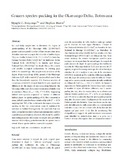Grazers species-packing in the Okavango Delta, Botswana

View/
Date
2007Author
Bonyongo, M.C.
Harris, S.
Publisher
Willey Blackwell Publishing http://eu.wiley.com/WileyCDA/Brand/id-35.htmlType
Published ArticleMetadata
Show full item recordAbstract
We used body weight ratio to determine the degree of species-packing of the Okavango Delta (22,000 km2) grazers and compared it to that of four conservation areas
of similar sizes but varying in the diversity of habitat types.
They are Etosha National Park (23,175 km2) in Namibia, Hwange National Park (14,621 km2) in Zimbabwe, Kafue National Park (24,000 km2) in Zambia and Kruger
National Park (19,633 km2) in South Africa. We considered possible ecological explanations for existing gaps within the assemblage. The weight ratio (measure of the degree of species-packing) of the grazers of the Okavango Delta was 1.25, with a total of 27 species which was far less than the theoretically expected 2.0. One-way analysis of covariance (ANCOVA) showed that there were significant differences in the degree of species-packing between the Okavango Delta and other conservation areas of similar size in southern Africa (F1,5 ¼ 166, P < 0.001). Regressing habitat heterogeneity (expressed as number of different
habitat types) on species-packing of the five conservation
areas yielded a positive linear relationship with R2 ¼ 0.76 implying that 76% of the variation in the degree of speciespacking in the five conservation areas is explained by variation in habitat heterogeneity. We conclude that size
ratios are useful descriptors of animal communities and it is a useful measure of species diversity, which can be used for monitoring purposes. Imbalances in weight ratios provide a measure of identifying perturbations due to species loss or
arrival of new species within a natural ecosystem.
Collections
- Research articles (ORI) [270]
